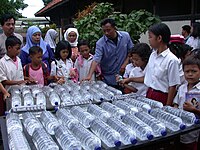
Photo from wikipedia
Two billion people worldwide consume unsafe drinking water. The problem is particularly pronounced in Sub-Saharan Africa, where more than a quarter of the population relies on unimproved surface water sources.… Click to show full abstract
Two billion people worldwide consume unsafe drinking water. The problem is particularly pronounced in Sub-Saharan Africa, where more than a quarter of the population relies on unimproved surface water sources. Based on the principles of solar water disinfection (SODIS), a new household water treatment technology, the SODIS bucket, was developed to improve the microbial quality of water from these sources based on controlled tests in a laboratory setting. This study set out to evaluate the efficacy of the technology in a field setting, in rural communities in the Chikwawa District in southern Malawi. SODIS experiments were carried out in two different vessels (1-L PET bottles and 20-L polypropylene SODIS buckets), over three months using unprotected water sources normally used by community members. Vessels were exposed to direct sunlight for 8 h per day in a village setting and were sampled at regular intervals to determine total coliforms, E. coli, turbidity, UV transmittance and UV dose. In these experiments, the SODIS bucket reached inactivation targets for E. coli (<1 CFU/100 mL) in two of seven experiments and for total coliforms in one of seven for total coliforms (<50 CFU/100 mL), despite having greater UV doses than were seen in the evaluation carried out under controlled conditions during the bucket's development. PET bottles reached inactivation targets for both E. coli and total coliforms in five of seven experiments. There was no single factor that could be identified as preventing adequate inactivation, but the role of organic matter, inconsistent nature of the water source, and vessel size, when coupled with organic matter, were identified as contributing factors. This study highlights the need for further prototyping to provide a suitable pre-treatment step for unprotected water sources, and the importance of field testing with real-life parameters to ensure new technologies are context appropriate.
Journal Title: International journal of hygiene and environmental health
Year Published: 2021
Link to full text (if available)
Share on Social Media: Sign Up to like & get
recommendations!